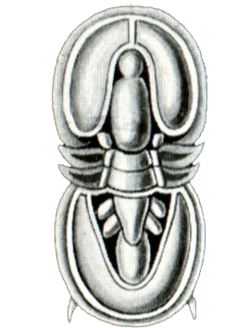User:Abyssal/Portal:Ediacaran
IntroductionSelected article on the Ediacaran world and its legacies
The Ediacara biota consisted of enigmatic tubular and frond-shaped, mostly sessile organisms that lived during the Ediacaran Period (ca. 635–542 Ma). Trace fossils of these organisms have been found worldwide, and represent the earliest known complex multicellular organisms. The Ediacara biota radiated in an event called the Avalon explosion, 575 million years ago, after the Earth had thawed from the Cryogenian period's extensive glaciation. The biota largely disappeared contemporaneously with the rapid increase in biodiversity known as the Cambrian explosion. Most of the currently existing body plans of animals first appeared in the fossil record of the Cambrian rather than the Ediacaran. For macroorganisms, the Cambrian biota appears to have completely replaced the organisms that populated the Ediacaran fossil record, although relationships are still a matter of debate.
Multiple hypotheses exist to explain the disappearance of this biota, including preservation bias, a changing environment, the advent of predators and competition from other life-forms. Breandán MacGabhann argues that the concept of "Ediacara Biota" is artificial and arbitrary as it can not be defined geographically, stratigraphically, taphonomically nor biologically. He points out that 8 particular fossils or groups of fossils considered "Ediacaran" have 5 taphonomic modes (preservation styles), occur in 3 geological periods, and have no phylogenetic meaning as a whole. (see more...) Selected article on the Ediacaran in human science, culture and economics
The history of paleontology traces the history of the effort to study the fossil record left behind by ancient life forms. Although fossils had been studied by scholars since ancient times, the nature of fossils and their relationship to life in the past became better understood during the 17th and 18th centuries. At the end of the 18th century the work of Georges Cuvier ended a long running debate about the reality of extinction and led to the emergence of paleontology as a scientific discipline.
The first half of the 19th century saw paleontological activity become increasingly well organized. This contributed to a rapid increase in knowledge about the history of life on Earth, and progress towards definition of the geologic time scale. As knowledge of life's history continued to improve, it became increasingly obvious that there had been some kind of successive order to the development of life. After Charles Darwin published Origin of Species in 1859, much of the focus of paleontology shifted to understanding evolutionary paths. The last half of the 19th century saw a tremendous expansion in paleontological activity, especially in North America. The trend continued in the 20th century with additional regions of the Earth being opened to systematic fossil collection, as demonstrated by a series of important discoveries in China near the end of the 20th century. There was also a renewed interest in the Cambrian explosion that saw the development of the body plans of most animal phyla. (see more...) Selected image
Did you know?
GeochronologySeries - Terreneuvian - Cambrian Series 2 - Cambrian Series 3 - Furongian Geography - Pannotia - Baltica - Gondwanaland - Laurentia - Siberia Fossil sites - Walcott Quarry Researchers - Stephen Jay Gould - Simon Conway Morris - Charles Doolittle Walcott Quality ContentFeatured Cambrian articles - None SubcategoriesRelated contentAssociated WikimediaThe following Wikimedia Foundation sister projects provide more on this subject:
|























